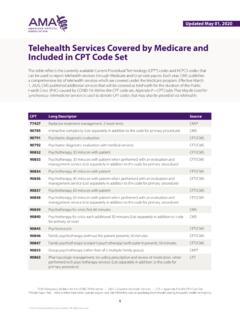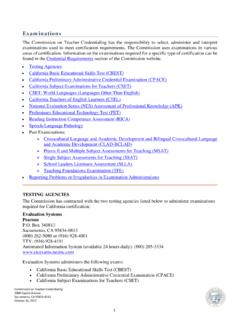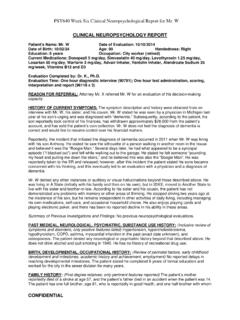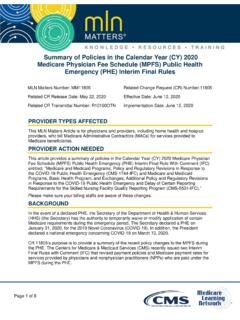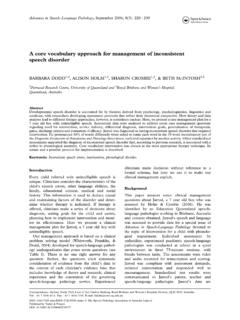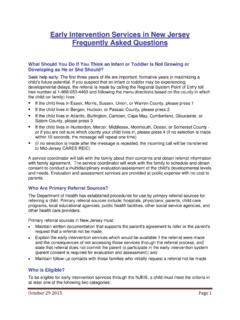Transcription of SLP Test Comparison Tests were selected for inclusion in ...
1 TESTC linical evaluation of language Fundamentals, 5th (CELF-5)Assessment of Literacy and language (ALL)Test for Examining Expressive Morphology (TEEM)Structured Photographic Expressive language Test Third Edition (SPELT-III)Structured Photographic Expressive language Test Second Edition, Preschool (SPELT-P2)Preschool language Scales Fifth Edition (PLS-5)Test of language Development Primary: Fourth Edition (TOLD-P:4)Test of language Development Intermediate: Fourth Edition (TOLD-I:4)Comprehensive Assessment of Spoken language (CASL)Expressive One Word Picture Vocabulary Test 4th Edition (EOWPVT-4)Oral and Written language Scales, 2nd (OWLS-II)Peabody Picture Vocabulary Test Fourth Edition (PPVT-4)Receptive One Word Picture Vocabulary Test 4th Edition (ROWPVT-4)
2 language areasSemantics, Morphology, Syntax, PragmaticsSemantics, Phonology, Morphology, SyntaxMorphologyMorphologyMorphologySema ntics, Morphology, SyntaxSemantics, Phonology, Morphology, SyntaxSemantics, Syntax, MorphologySemantics, Morphology, Syntax, PragmaticsSemanticsSemantics, Syntax, PragmaticsSemanticsSemanticsLiTeracy areasSupplementary Ages 8-21; Reading Comprehension Structured Writing Letter Knowledge, Rhyming, Print AwarenessNoneNoneNonePrint Awareness; Alphabet Knowledge; Initial Sounds, Rhyming, Morphological AwarenessSyllable SegmentationNoneMorphological Awareness NoneNoneNoneNoneDiaLecT consiDeraTionsAfrican American English (AAE), Southern English, Spanish-Influenced English, Asian-Influenced English (Pg.)
3 277)African American EnglishNot ReportedAfrican American EnglishAfrican American EnglishAfrican American English, Appalachian English, Southern English, English Influenced By Chinese, English Influenced By Spanish NoneNoneNo Specific Scoring; Rely On Clinician (Pg. 31)Not ReportedAfrican American EnglishNoneNot Reportedrace/eThniciTy of norming sampLeWhite ( ), Hispanic: (20%), African American ( ), Asian ( ), Other ( )Spring Sample: African American ( ), Hispanic (18%), White ( ), Other ( )Not ReportedAfrican American ( ), White ( ), Hispanic ( ), Other ( )African American ( ), White ( ), Hispanic ( ), Other ( )African American ( ), Asian (4%), Hispanic (18%), White ( ), Other ( )European American (78%), African American (15%), American Indian/Eskimo (1%), Asian/Pacific Islander (4%), Two Or More (2%), Other (<1%)European American (78%), African American (14%), American Indian/Eskimo (1%), Asian/Pacific Islander (5%), Two Or More (2%), Other (<1%)African American ( ), Hispanic ( )White ( ), Other ( )African American ( ), Asian American ( ), Caucasian ( )
4 , Hispanic (18%), Native American (1%), Other (.3%), Not Reported ( )Not ReportedAfrican American ( %), Hispanic ( ), White ( ), Other ( )African American ( ), Asian American ( ), Caucasian ( ), Hispanic (18%), Native American (1%), Other (.3%), Not Reported ( )norming By geographyMidwest, Northeast, South, WestNorth Central, Northeast, South, WestFresno, CaliforniaMidwest, Northeast, South, WestMidwest, South, West, EastNortheast, South, Midwest, WestNortheast, South, Midwest, WestNortheast, South, Midwest, WestNorth Central, Northeast, South, WestNorth Central, Northeast, South, West East, South, Midwest, WestNorth Central, Northeast, South, WestNorth Central, Northeast, South, West (p.)
5 42)norming By normaLcy SWD: 20%SWD: SWD: 0 SWD: 7%SWD: : : .4%SWD: : 4%SWD: : : : ReportedSWD: : SD: 85% (from test administration manual) Unacceptable (Leaders, 2014, ) SD: 86%-2 SD: 90%(Merrell & Plante, 1997)Cut Score: 9590%(Perona , 2005)Cut Score: 8790%(Greenslade, 2009)> -1SD: 83%(from test administration manual) Insufficient (Leaders, 2013, )Cut Score: 9074%Cut Score: 9077%Not ReportedNot ReportedNot ReportedNot ReportedNot SD: 85% (from test administration manual) Unacceptable (Leaders, 2014, ) SD: 96%-2 SD: 95%(Merrell & Plante, 1997)Cut Score: 95100%(Perona , 2005)Cut Score: 87100%(Greenslade, 2009)> -1SD.
6 83%(from test administration manual) Insufficient (Leaders, 2013, )Cut Score: 9088%Cut Score: 9088%Not ReportedNot ReportedNot ReportedNot ReportedNot ReportedSLP Test ComparisonTests were selected for inclusion in this publication because of reported use by Virginia School SLPs OR because of acceptable levels of diagnostic accuracy. SLPs are encouraged to access examiner manuals and examine diagnostic accuracy (sensitivity and specificity) and normative samples prior to selecting a test for administration. This information was compiled by researchers at James Madison University for the Virginia Department of Education. Explanation of the terms used in this chart are provided on the inside right Tests have a mean of 100 and Standard Deviation of 15 a written report includes a standard score.
7 The corresponding confidence interval at 90% or 95% should also be AssessmentReference forSpeech- language PathologyPlease use these definitions when reviewing the chart Areas refer to the specific areas of language the test developers report the test Areas refer to the specific areas of literacy the test developers report the test Considerations refer to the specific dialects that test developers provide optional scoring considerations for in the administration Sample refers to the group of individuals whose performance data are used as a reference for evaluating individual test scores. The individual being evaluated should be represented in the normative sample for the test being used.
8 Race/Ethnicity of Norming Sample refers to the sub groups that made up the normative sample for the Residence refers to the areas of the country where individuals in the normative sample reside. Normalcy of subjects refers to normative samples that included specific sub populations that may alter the overall distribution of scores. Tests that included students with disabilities (SWD) and students identified as gifted are indicated in this column. Sensitivity refers to the rate at which a test can correctly identify students with language impairments as having a significant deficit. Specificity refers to the rate at which students who have typically developing language abilities are found by that test to have adequate language performance.
9 SWD - Students With DisabilitiesVirginia Department of Education, Division of Special Education and Student ServicesConsideration of Cultural and Linguistic BiasLocal dialectal and cultural variations exist within the school division. Students, who are native English speakers, may use dialects and speak or write following the language patterns of their community. Educators should use the student s community language , not race, when considering dialect use. Teams should recognize that accents and regional vocabulary differences are a natural part of spoken language and should not be considered a disorder. Norm-referenced test scoring procedures based on use of Standard American English may potentially penalize students who use other dialects or languages.
10 When using norm-referenced Tests with students who come from culturally and linguistically diverse backgrounds, provide consideration for dialect use and consider use of other assessment procedures. To avoid biased or inaccurate reporting of results for students from culturally-linguistically diverse populations, SLPs should address cultural or linguistic differences in the evaluation Against Over Reliance on Norm-Referenced TestsNorm-referenced measures are not sufficient sources of data for determining eligibility for special education or the educational impact of a speech - language impairment. Norm-referenced measures usually cannot distinguish between communication disorders and communication differences due to instructional, cultural or dialectal experience.











